Given this has been a sad and single issue kind of day, I thought some might like little distraction, and a bit of a nod to the new British monarch, who happens to be an old environmental warrior. Happy reading for World EV Day.
Category: EV Trips
Lessons from the Road
Blogging has taken a back seat as Hurry Krishna (HK) now has a gig with your go-to Electric Vehicle Webzine, The Driven https://thedriven.io/
Meanwhile, some of you might enjoy an interview with HK just published in the Fremantle Shipping News
Eat, Preach, Drive
EV drivers get spoilt on the Nullarbor. Pretty much every roadhouse owner (not that there are many) with a plug point will let you charge overnight. Grey nomads (not that many of them here either) tumbling out of their enormous 4WDs will be solicitous ‘are you crazy or are you writing a book? (No!) Where do you charge (‘pretty much the same places as you – only slower…’)
The attention goes to your head: your ‘virtue signalling’ is rampant, opportunities for proselytising irresistible. ‘Price? this car? About half-way between a petrol SUV and your 4WD…and we are charging for free or next to nothing’ you say, knowing that they have just parted with about $200 to fill their car.
There are opportunities too, to promote the value of installing EV chargers to the receptive business owners, while sampling Buffalo salami and Camel milk ice-cream at Harry’s Home Made Fine Foods in Baroota, S.A.


In Port Augusta, we came across our first competing EV. The charger is booked for us only until 7 pm, we are told at the motel. Fine, we said, but can we please book it again for 7 a.m for a final top-up before we leave?
7 p.m change-over works fine. Not so much the early morning swap. The Tesla has completed charging but is still plugged in and, understandably, the reception staff are not willing to call a customer at the crack of dawn. Unhappy, we adjust our route a little to drive via Tanuda, Barossa Valley, which looks perfect for a lunch and a fast-charge.
Tanuda is, indeed, quite lovely, but its one charger is serving another client, a beautiful electric Volvo. Soon another Tesla is lining up beside us. Thankfully, the Volvo owner turns up in half hour or so. He has the patience of a saint, I realise after I have read him my ‘Complete Discourse on the Necessary Etiquette of EV Charging.’

On the main arteries between Adelaide and Sydney, fast charging stations are plentiful. More are coming on line every month, many are conveniently located in petrol stations and shopping centres. But given the variable charging times of EVs even on the ultra-fast chargers, there are bound to be instances where demand exceeds supply.
Conventions for sharing assets take time to develop. In the meanwhile it might make sense to work out some good practice, for example
- Limit charging periods, especially when there are others in the queue.
- Register on Plug Share if you are charging or waiting.
- Set up your car so it can be disconnected when it’s finished charging by waiting drivers (so you won’t have to rush your drink at the pub).
Just commonsense, the sort of stuff we mostly do but can easily forget in a rush.
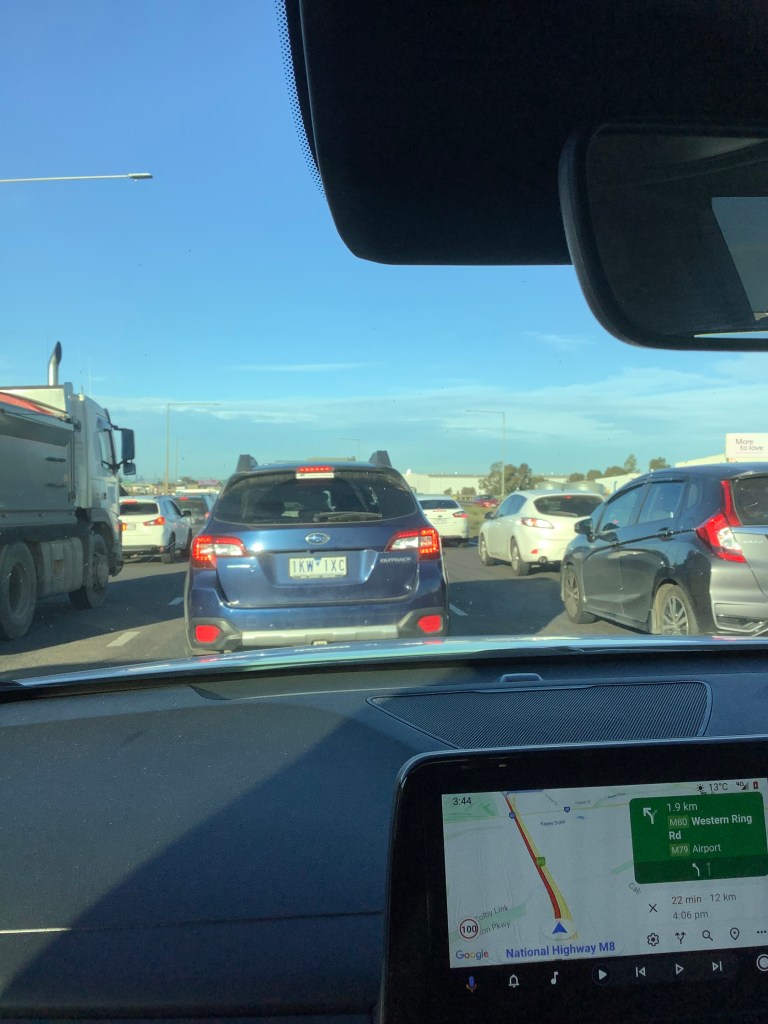

We skirted north of Adelaide, and 2 days after leaving Port Augusta crawled into Melbourne in bumper to bumper traffic. Our first big city in 10 days dazzled us with the best chai and dosa since my teenage years in Kolkata. Then a couple of days meandering in the narrow hilly lanes of the Yarra Valley, slow enough to notice mystifying unmarked sculptures and not run-over a wombat in the dark.
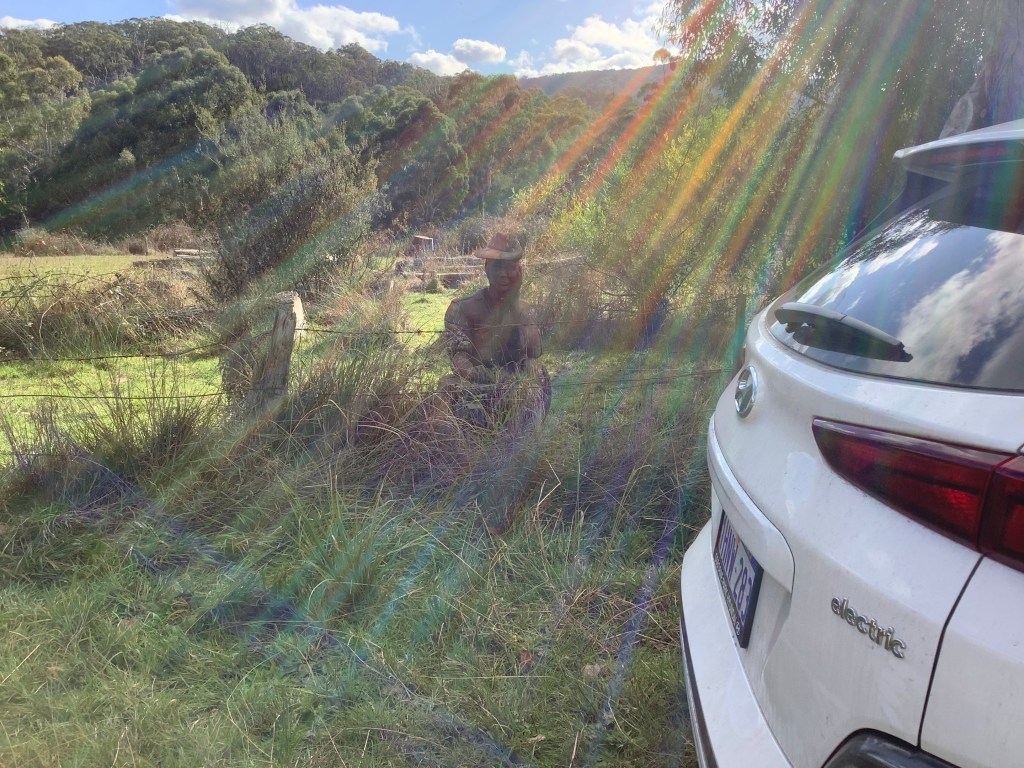
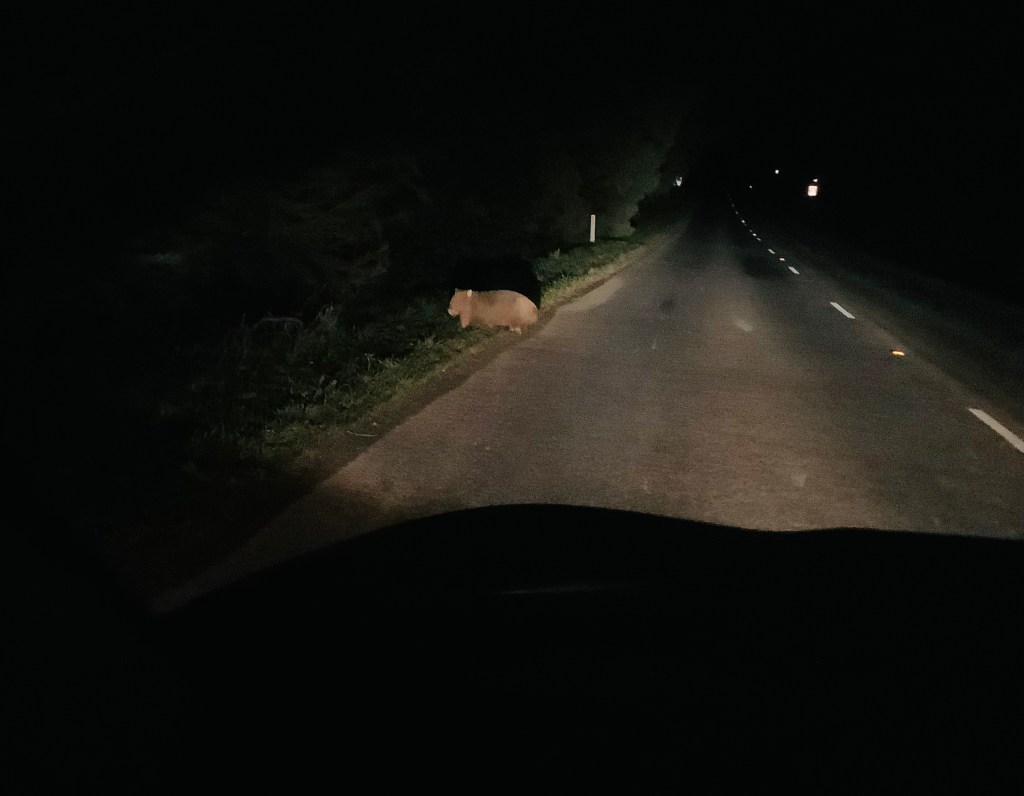
On our first day out of Melbourne on the M31 towards Sydney, I finally came to grips with the question of speed:range ratio of an EV. Where charging stations abound, and provide insurance against range anxiety, why not join the average Motorway user at 110 kmph?
The only problem is that everyone else is driving just a little faster, overtaking and slowing you down just that little bit.
When the 13th car overtakes you – incidentally it’s a ute – you give into a less virtuous self who sits just beneath your environmentally-friendly-echo-plus type driving persona. Johnny in the ute sees just a silver flash, then 12 other small and large vehicles vanish into a blur in your rear vision mirror. By the time you notice you have been, ahem, going a little over the speed limit, the car range has dropped dramatically and you are not going to make Gundagai without another charge!
We have to stop for a charge at Tarcutta. Co-pilot sets the car to charge up to 85%. It will take nearly 2 hours. By the time we make Gundagai, the sun will have set and I won’t be able to take a photo of the great Aussie icon, the ‘dog on the tucker box’. But co-pilot and I are no longer on speaking terms, so negotiation is impossible. Never mind. Missing a photo op is a small price to pay for guilty pleasures. And there’s just enough light to catch the Giant Koala.

For the record: 4700 kms Fremantle to Sydney in Kona EV 2022 – done. Easy, safe, with just a light sprinkle of excitement.
A 21st Century Pilgrimage
What is this that roareth thus?
Can it be a Motor Bus?
Yes, the smell and hideous hum
Denotes a motor bus!
Alfred Denis Godley, 1914
There is no odious fume, nor the visceral grumble of the engine as your electric car glides over the well-maintained surface of the thousand miles of Eyre Highway (https://en.wikipedia.org/wiki/Eyre_Highway) from the empty eastern end of Western Australia to Port Augusta in South Australia. Your car is perfectly silent or filled with your favourite music. The white noise hum from the rubber on the road might put you to sleep but for the bone-rattling thunder of monstrous road trains every so often.
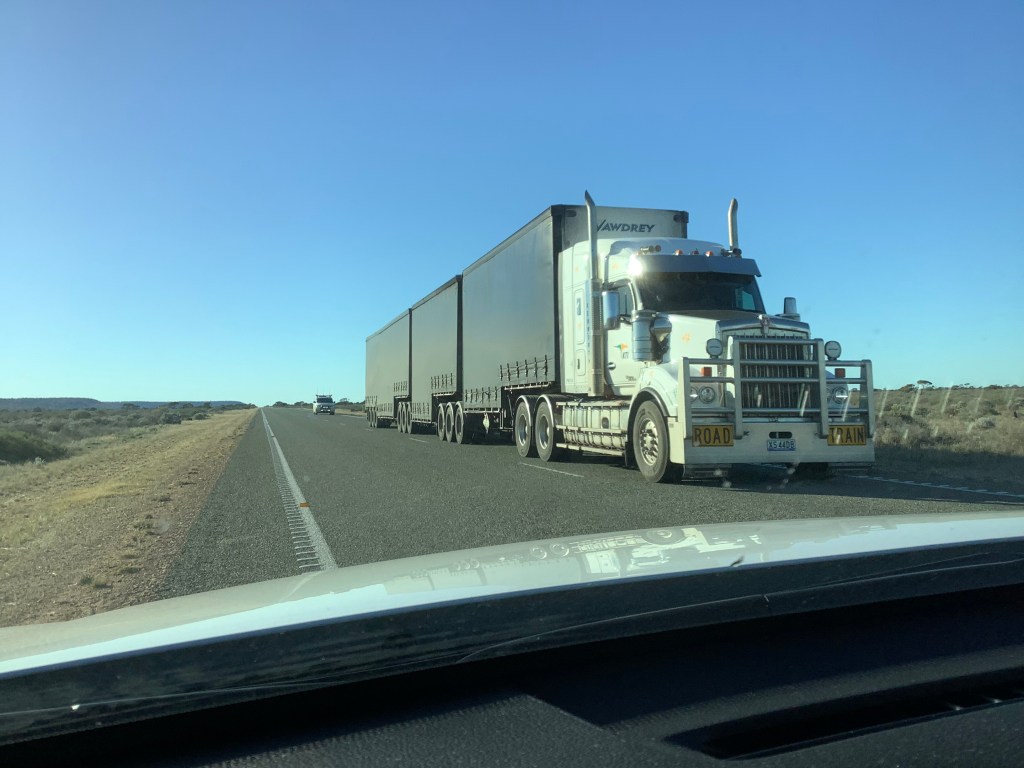
Having struggled with range-excitement on Day One (https://readingontheroad54893552.wordpress.com/2022/06/23/range-anxiety/) we settle into driving around 400 km a day, at about 10 km under the 110 km/ph speed limit on the wide open roads. The car is set to move at the most ecologically friendly mode that our KonaEV has to offer. Though the cold desert mornings dampen the range projection a little, on crisp sunny days we can do without any climate aides. So, most days, we seem to be getting around 430 kms on a 90%-ish battery.

This road-trip has all the hall-marks of a pilgrimage. We are following in the foot-steps (perhaps I should say the wheel tracks?) of many who have gone before – doesn’t everyone of a certain age have a story of crossing the Nullarbor in a petrol-guzzling bomb some time in the late 20th century?
Like any great pilgrimage, this flat and featureless road has its own essential icons. The iconic ‘90 mile straight’, Australia’s longest straight road (though it’s apparently only the 11th longest-straight in the world – but hey, this is not a competition) brings us from Balladonia to Caiguna, which hosts by far the most important attraction for the EV-community: a 50 kw DC charger, fastest charger by far on the entire 1000 kms of the Eyre highway!
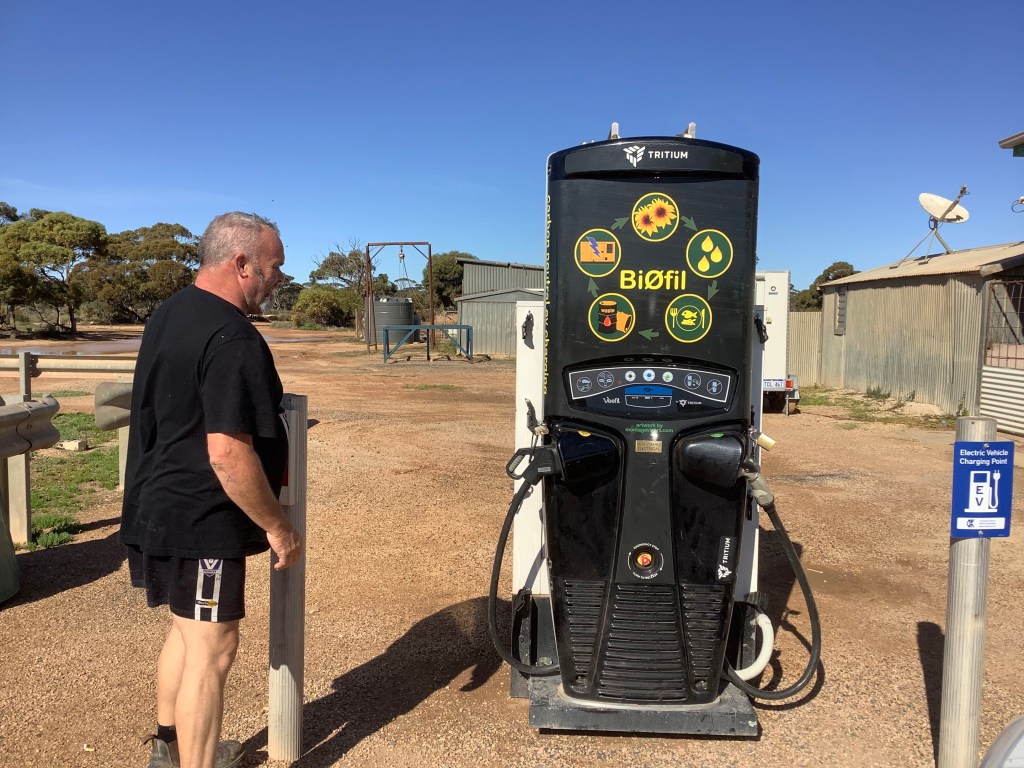
The eco-aware EV drivers will be happier still to learn that this charger is carbon neutral, running as it does on the waste oil from all the fish and chips fried at the Roadhouse. (https://www.abc.net.au/news/2022-01-17/first-fast-charger-for-electric-vehicles-installed-on-nullarbor/100762138) For a flat fee of $50 you can fill up your car in an hour or two. More importantly, this might be the only place in the world, where you can feel virtuous while stuffing your face with battered fish, as you bask in the glow of saving the earth one french fry at a time. Not all chargers are quite so spectacular.
Two other relatively fast chargers at the Balladonia Hotel and at the Madura Pass Oasis Motel are connected to a research project (https://robotics.ee.uwa.edu.au/rev/) led by engineers at the University of Western Australia (in case of any perception of conflict I should declare that I spent many happy working years at that university). Other charging options are mostly slower, generally three-phase plugs hidden out of sight behind a toolshed or in far corners of roadhouses, whose principle customers are, of course, still, the massive transport vehicles that enter these premises to engorge on fossil fuels.
Nonetheless, there are on the Eyre Highway, at least 10 points where we could charge our car – most are slow, so it is most practical to charge overnight, replenishing yourself and your car at the same time and in the same motel. And, best of all, given the very low numbers of EVs here, you are unlikely ever to have to wait in line.

We left Fremantle on the West Coast of WA on a Sunday. The following Sunday, having broken no speed records, we were in Port Augusta on the eastern bank of Spencer Gulf, South Australia.
We had driven just over 2,500 kilometres: some of it through the ancient fragile land of the Yalata people; much of it though vast central Australian Desert, the Nullarbor, named thus because the Europeans saw no trees, but which is in fact covered in low shrub.
We cross the Great Australian Bight, where the world’s ‘largest exposure of lime stone bedrock’ (https://en.wikipedia.org/wiki/Nullarbor_Plain) plunges abruptly into the ocean. The road is a silver thread stitching together a haunting, implausible landscape of a greying desert and a green ocean. You can love this path in any car but you will do less harm in an electric one.

So… what are you waiting for?
Range Anxiety
Range Anxiety is the EV’s contribution to the English language. The term entered the Oxford English Dictionary in 2013: ‘worry on the part of a person driving an electric car that the battery will run out of power before the destination or a suitable charging point is reached.’
In some parts of the world, such anxiety is, arguably, a matter of the individual psyche (https://www.pitchcare.com/news-media/range-anxiety-fact-or-fiction.html). But in much of this vast land, basic infrastructure for these cars (ie. charging stations) is in its infancy, so unregulated that you need a half a dozen different apps and attachments to be able to access a sufficient number of chargers on any long trip. Add to that the sparseness of most things in outback WA, and you have a perfect habitat for the dreaded Range Anxiety in the novice EV driver’s head!
Just 45 minutes and 50 km out of Fremantle, the speedometer indicates we have used 11% battery and one of my apps is showing ‘McDonalds, Mundaring’ charger nearby – motor car owners staggering under petrol price rises, please take note: it is free. But it will take an hour and 45 minutes to fill up the car!!! So begins a long debate between me and my Range Anxiety (henceforth RA).
Me: we don’t need to top up the battery
RA: more experienced drivers say you should top up when you can when you are on unfamiliar roads.
Me: Not unfamiliar!! We drove to Adelaide in a clapped out Honda Civic…
RA: Yes, in 1988…
I take the point but persist, pointing at a popular app: look, we get to the next charger at Merredin in 250 kms – we have plenty of battery to do that.
RA: but what if the Merredin one is not working? Or if your car will not charge as fast as the app says?
‘What if’ is always Anxiety’s killer punch! New car, we don’t know its quirks. And we know the uncertainties around charging points. They can work differently for different cars. For instance, our Hyundai Kona Extended Range goes a longer distance per charge, but depending on the charging technology, it can be much slower to charge up than its cousin, the Hyundai Ionic 5. And some chargers indeed are damaged, vandalised or simply may not charge at the anticipated rate. And everything from temperature to rain to road surface can affect the range of an electric car. Anxiety wins. We stop for nearly 2 hours to add just 50 kms of additional range.
It would be 2 days before we worked out that the last 10% of battery is always the slowest to charge up – not worth the time unless you really need the full range. On Day 1, we are at the bottom of a steep learning curve.
At the Merredin Community and Leisure Centre charging is happily, yet again, free and the rate of charging substantially faster than at Mundaring. Even so, it will be 6 hours before the car is fully charged. This time we bargain Anxiety down – 80% charge will get us comfortably to our destination for the night. And that will be done by about 4 in the afternoon. We tether the car to the charger and walk to Merredin’s only eatery operating this Sunday afternoon!
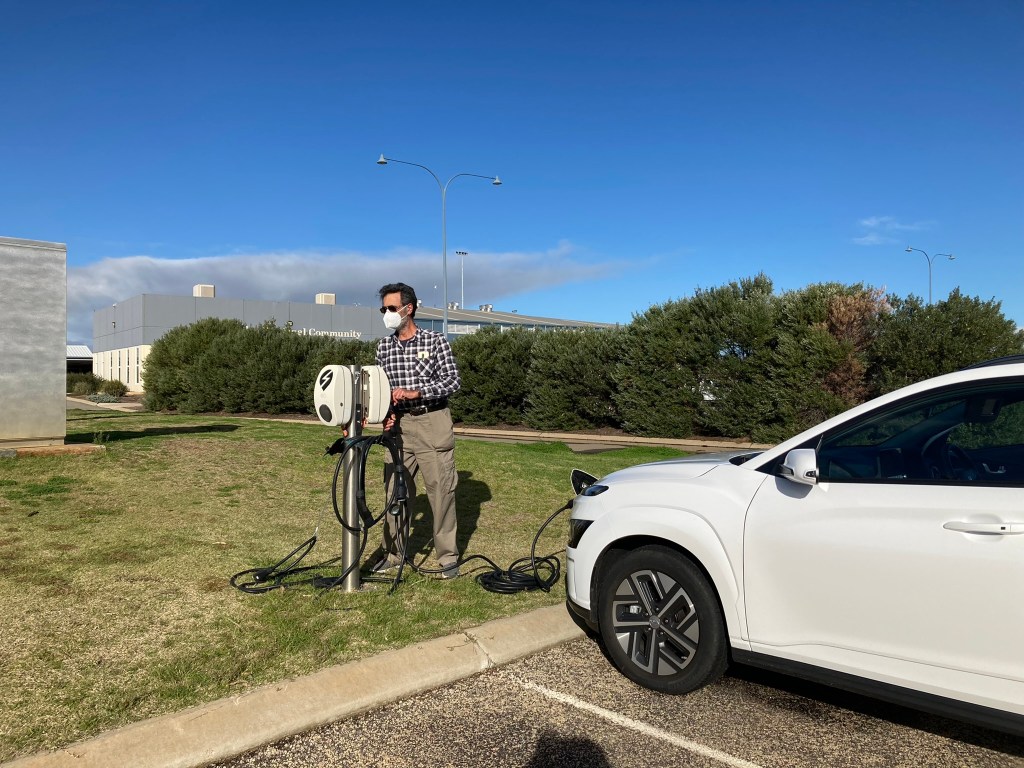
And this is when the real problems start. My co-pilot finds a Tesla charger which promises a faster charge. So we run back and carefully follow the instructions to un-tether our car from the charger: but the plug won’t release! First gentle persuasion, then increasingly forceful coaxing – the thing won’t budge! We try randomly turning things off and on several times – same result each time – the car remains fixed to the charger. Co-pilot searches the web – but this is not a common problem and consequently the web offers no solution!!
Following my damsel-in-distress instinct, I hail a group of men playing bowls. The lovely gentlemen, between them, have a thousand years of driving experience but are seriously befuddled by a car without a motor!
Meanwhile co-pilot has EV expert, J, on the phone and he too has never encountered a clingy charger until now. Yet, somehow, J talks co-pilot through the options and (phew!) at some point, after repeatedly hitting an ‘unlock everything’ button on the driver’s door (which we did not know existed until this point), the charger releases it’s grip on the car!! This process has taken an hour and we still have quite some charging to do before we can be confident about reaching our accommodation for the night.

So, to the TESLA charger we go and it works and the car screen shows that we will get the charge we need (without too much concession to Range Anxiety) by about 5 pm. And this charger too, is free!!
Meanwhile, our accommodation arrangements have gone awry, for reasons too tedious to explain. Eventually, we drive 3 hours in the dark and rain, the ‘range’ gauge dropping rapidly as headlights, wipers, de-misters, all draw on battery power. For our first night, we have no options but the caravanpark at Coolgardie, where you would not want to stay except in an emergency! But on the positive side, there is a caravan park plug point at which the car charges very slowly for the next 12 hours – and that is just enough to get us to the next charger in the morning.

Best thing ever: total ‘fuel’ cost for 600 km of driving? $0
First test for the long-distance EV driver: meet and beat Range Anxiety.
That done, with a little planning and some intriguing chargers (wait for the next post), the trip is turning out to be both entertaining and educational!
Crossing the Nullarbor! Or not?
You to the Universe, aka, Face Book: ’We are planning to drive Perth to Sydney, and hopefully back again, in our new Electric Vehicle (henceforth, Evie). Any advice?’
First responder : No! Mate!! Seriously, Don’t do it.
Like Donald Trump we ignore reasonable counsel against self-destructive stupidity. Eventually more supportive advice flows in and we find at least three real people who have really done the distance.
So begins the planning for the 5000 km drive across the flattest, longest, straightest road in the world with less trees, people and EV charging stations per thousand kilometres than most places you care to name. (https://en.wikipedia.org/wiki/Nullarbor_Plain)
Unlike this blogger’s usual sojourns on foot, this trip is not going to be 100% guilt-free as many of the charging stations, where we will figuratively ’fill up’ the car, have fossil fuel generated electricity. (See https://www.mynrma.com.au/cars-and-driving/electric-vehicles/our-mission/are-evs-better-for-the-environment). Still, by most calculations, our environmental impact for this trip will be less than half of a petrol-guzzling, ozone ripping, air-polluting jalopy (I learnt that word from doing the Guardian crosswords and just had to use it).
Some say a previous Hyundai electric car was known to burst into flames for no apparent reason – but that was several generations (of cars) ago and we are assured by the dealer that that model is in no way related to our own Evie, who is a slick, white, 2022 Kona, with an enviable reputation for doing 480k on a full tank (i.e. 100% charge), on a good day. The equivalent more posh brand car costs 25% more.
She is cheap to fill up. For our test run, about 650 km Fremantle to Augusta round trip, we spent less than $15 on charging.
But there is a whole other language to EV ’filling up’ that ICE owners know nothing about. (If you don’t know what ICE is, I’m pretty sure you drive one! ICE = Internal Combustion Engine, in other words, most of the cars on the road.)
The most important question for an EV owner is ‘how long does it take to fill my car?’ The answer: how long is a piece of string? You will get a different answer depending on the type/model/year of car owed by the inquirer + the type/model/year of car owned by the responder + the charging station where this conversation takes place + the various cables that you should have bought but did not, plus 21 other variables I cannot remember.
Walking Buddy, WB, now re-classified as FM (Fast Mover) has read thousands of documents and composed a 400 page manuscript titled ‘Number, Length, Strength, Shape and other Variables of EV Charging Plugs and Cables: Essential Considerations Prior to your Long-Distance Motoring Adventures.’ As this is an open-ended discursive thesis, the work ends with no recommendations on what one can actually do to ensure availability of power to your car on the Nullarbor!
In any case, I really wanted the plug called Pig-tail because it has a cute name, but FM insists that name nothing to do with efficacy. In the end, the nice people from Hyundai HQ in Sydney stepped in to save the day (and a beautiful friendship) by offering us a full set of charging cables. HOWEVER, there’s a catch. These will be available at Port Augusta, which is after we have crossed the most remote stretch of the road.
Meanwhile we are setting off with a ’granny charger’ (which sounds slightly obscene and takes more than 30 hours to charge the car from 0-100), a type 2 (not to be confused with diabetes) and something called ’3-phase-5-pin’ (I-give-up) that FM has borrowed from more knowledgeable EV owners, which, used wisely, hold the promise of charging for just four or five hours most days. But hey, it’s not a race (as our coal-fired ex-PM once said).
Still, I wonder what will happen if Evie runs out of puff in the middle of nowhere (which is what the 2000 km between Perth and Port Augusta is)? FM has armed himself with an extra-long cable, which weights so much, I think it could be 100 kilometres long. But even so, the prospect of walking into a town with one end of an extension cable in your hand is hardly appealing!

Experienced EV drivers say, if running low on battery you should drop the speed to 40 kmh. That will extend the distance you can go before your next charge. At that speed, we should be in Sydney in 3 or 4 months.
Bryce Gaton, a respected expert on all things EV and Kona-owner, is crossing the Nullarbor east to west. He recommends patience!
So, we’ll go Leonard Cohen slow:
I’m lacing up my shoes
But I don’t want to run
I’ll get there when I do
Don’t need no starting gun
Please stay tuned for more slow-mo blogs, so you’ll be the first to know when we are stuck somewhere without a plug point within a 100 km radius!!!
#electriccar, #hyundai,



